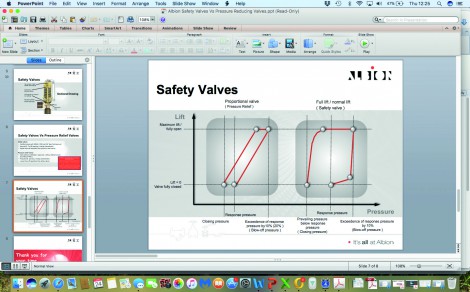- Home » Editorial » Hydraulics
SAFed and sound with Albion Valves

New guidelines published by SAFed have been introduced surrounding pressure relief valves and safety valves. Les Littlewood, sales director at Albion Valves (UK) Ltd, outlines the key points and the correct usage for both pressure relief and safety valves along with the differences between them.
The Safety Assessment Federation (SAFed) represents the UK’s independent engineering inspection and certification industry, which plays a key role in maintaining high standards of safety within the workplace. The organisation acts as a focal point for all issues and concerns relating to the safe use and operation of plant, machinery and equipment.
The new SAFed guidelines were put in place following an industry increase in the use of pressure relief valves in applications that required a safety valve. These valves are commonly mis-used due to a perceived cost-saving solution by using pressure relief valves instead.
New guidelines
The new guidelines set out by the Pressure Equipment Committee will help engineers avoid the occurrence of dangerous overpressure situations. The guide focuses on areas such as optimal set pressure, discharge capacity of valves and design temperature of valves. It also highlights the risks of using pressure relief valves instead of safety valves, a practice which has become increasingly common in recent years.
In a pressurised system both safety and pressure relief valves are used as the last safety device. However, engineers and specifiers need to be mindful that the requirements can vary significantly from system to system, and increasingly valves must now meet the EU’s Pressure Equipment Directive (PED) 2014/68/EU to guarantee safety. The key differences are: A pressure relief valve – the opening is proportional to increase in the vessel pressure. The opening of the valve is not sudden but gradual if the pressure is increased gradually. Safety Valve – the opening is sudden. When the set pressure of the valve is reached, the valve opens completely.
Correct usage
Understanding when to use the different types of valve is vital for engineers and installers, the summary below shows the key characteristics to bear in mind when making a selection,
Safety valves
• Certified valves with WRAS/PED and CE Type Test Approval
• Normal lift – Full lift opening/closing characteristic
• Higher blow-off capacities than pressure relief valves
Example application – A safety valve should be used for a boiler in a commercial building
Pressure relief valves
• Valve without certification/approval (without safety function according to PED)
• Proportional opening/closing characteristic
• Lower blow-off capacities than safety valves
Example application – A pressure relief valve should be used to control the pressure in a manufacturing process
Consequences
In a pressurised system, both safety valves and pressure relief valves were being used. However, engineers and specifiers now need to be aware that valves must meet the EU’s Pressure Equipment Directive (PED) 2014/68/EU to guarantee safety and avoid catastrophic risks associated with specifying the wrong valve when assessing overpressure protection.
-
PPMA 2025
23 September, 2025, 9:30 - 25 September, 2025, 16:00
NEC, Birmingham UK -
Advanced Engineering Show 2025
29 October, 2025, 9:00 - 30 October, 2025, 16:00
NEC, Birmingham UK










